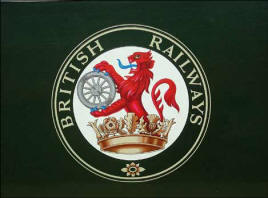
Home
List of Locomotives
List of
Rolling Stock
List of Other Inclusions
Download
**unavailable**
Project Team
FAQs
Site Design ©2006 Worley Web
Design - Graphical Set distributed under the GPL License
[ www.tt-forums.net
] - [
www.ttdpatch.net ]
|
Diesel
Locomotives
Contained
here is a list of diesel locomotives that are included in the BR Set. It
features locomotives from the very first moment that diesels were introduced
in 1948 to the latest Vossloh design. They are listed here in *class number*
and not year of introduction. The list of yellow at the bottom of each box
is a list of liveries that each locomotive was used in. Be aware that each
picture links to the page the image originates from.
Note that livery lists
are NOT exhaustive.
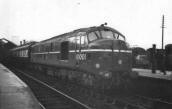 |
Class D16/1
The first British mainline diesel locomotive. The one in the set is
based on the two very first D16s, 10000 and 10001. They could often
be found hauling trains of both passengers and goods. They often
worked in multi-head formats. They were withdrawn in 1966 and 1962
respectively.
LMS Black, BR Green |
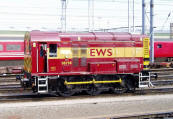 |
Class 08 Shunter
The most mass-produced locomotive in the British Isles. Almost 1200
of these shunters were made in just 9 years, with production ending
in 1962. Thanks to major overhauls, locomotives are kept looking
brand new like the one in this picture, but only a few remain in
mainline use today - fixed-rake trains have meant shunting duties
are now minimal.
BR Green, BR Blue, EWS, Cotswold Rail,
Various Others. |
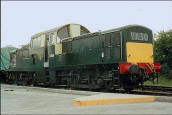 |
Class 17
One of the least successful of any BR Class. The 17 was a
centre-cab, long-bonnet locomotive, which limited visibility. On top
of this, the Paxman 6Z engine it was fitted with caused reliability
to be curtailed - official estimates lay at a meagre 60%. They were
phased out a mere 9 years after introduction, in 1971.
BR Green |
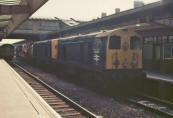 |
Class 20
A small and effective locomotive for light freight working. They
were also very rarely used on passenger trains, usually as relief
for the busy services to Scarborough and Skegness in the Summer.
They were built from 1957 until 1968, and many existed through until
the 1990s. A few remain today, mainly with the Harry Needle Railway
Company running the North East Steel routes for Corus. In the
picture, they are being used doubleheaded-nose-to-nose, which often occurred.
BR Blue, BR Green, DRS, Harry Needle
Railway Company, Railfreight |
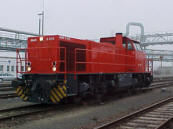 |
Class 21/5
(Vossloh)
These German locomotives were acquired by ECR, the European division
of EWS. The entire fleet was used in France, but four of the
locomotives were assigned TOPS numbers and are based near
Folkestone. They are brand new, introduced in 2005, and are used for
shunting and light freight work.
Maroon |
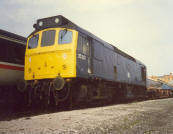 |
Class 25
One of the best diesel locomotives in terms of usage. They ran both
passenger and freight trains from 1961 through to their withdrawal
in 1987.
BR Blue, BR Green, BR Two-Tone Green |
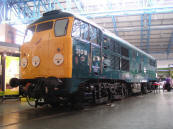 |
Class 31
Built from 1957-62, this was Brush's effort at a Type 2 locomotive.
It is still very much in use today, mainly by Fragonset - the
spot-hire charter company. They were previously used by EWS, but
they withdrew their final three 31s in 2001. Network Rail also
operates four 31s to haul test trains.
BR Blue, BR Green, BR Golden Ochre,
Regional Railways, Railfreight Gray, Civil Engineers, Trainload
Coal, Trainload Construction, Gatwick Express, EWS, Railfreight
Red/Grey, Wessex Trains Pink |
 |
Class 33
A real workhorse of the Southern Region, these locomotives were for
passenger services. They were built from 1960-62 and several remain
in use today, some on preservation railways, and a few with
Fragonset. Some also saw use with DRS, but there are currently none
in actual service.
BR Blue, BR Green, Fragonset Black,
Civil Engineers, SWT Desiro |
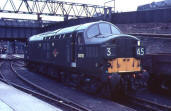 |
Class 37
One of the most famous locomotives. The 37 is a well-known British
locomotive introduced in 1955. Many are still in use today, making
it the oldest regular-mainline-use locomotive. It's most important
use today is to pull the West Highland section of the Caledonian
Sleeper.
BR Blue, BR Green, DRS, EWS, Fragonset
Black, Intercity Swallow, Railfrieght Grey, Trainload Metals,
Trainload Grey, West Coast Railway Company Maroon, Regional
Railways, Civil Engineers, Railfrieght Distribution |
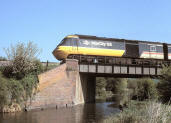 |
Class 43
The High Speed Locomotive that was the epitome of the British
Passenger Network for many years from their introduction in 1976.
They have been the diesel backbone of the East Coast Mainline for
many years, alongside the 91 Electric.
BR Blue, Intercity Swallow, First
GreatWestern, Virgin, GNER, Midland Mainline |
 |
Class 45
These 90mph passenger locomotives were best known for their work on
the Midland Mainline from London St Pancras. They were introduced in
1960, and were finally withdrawn in 1989. Fragonset owns one of
these, which is the final one owned by a non-heritage-line company.
BR Blue,
BR Green |
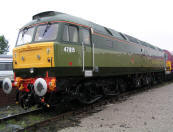 |
Class 47
The 47 is the most plentiful locomotive class, being introduced in
1962. A fairly large number remain in active service, mostly with
Cotswold Rail who supply 47s to One Railways.
BR Two-Tone Green, DRS, EWS, First
Great Western, Freightliner, Virgin Cross-Country, Cotswold Rail,
East Anglia/One, FM Rail/Fragonset, Police Car Livery [Riviera
Trains], West Coast Railway Company |
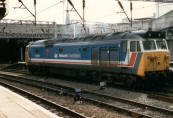 |
Class 50
Affectionately known as Hoovers because of their unique engine
noise, the class 50 was an express passenger locomotive used north
of Crewe from their introduction in 1967 before the electrification
of this part of the West Coast Main Line in 1974. They often worked
in pairs for the steep gradients. After the North WCML was
electrified, they were deployed to the Western areas of the network,
and worked many different passenger routes.
BR Two-Tone Green, BR Blue Large-Logo,
Network South East,
GWR Brunswick Green, LMS Maroon |
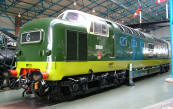 |
Class 55
A famous and well-used locomotive. Known as the "Deltic" because of
it's engine, 22 of these models were used to operate the East Coast
Main Line between Edinburgh and London. They replaced the Gresley
Pacifics, and with a running speed of 100mph, didn't lose out to
their steam counterparts. Six of these locomotives are being
re-introduced as chartered locomotives, owned by Deltic 9000
Locomotives Ltd.
BR Two-Tone Green, BR Blue |
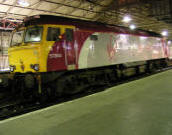 |
Class 57
As rebuilds of old Class 47s, the 57 was built between 1997-2004 at
Brush Traction, and was soon snapped up by several companies. Virgin
is the main owner, using 12 for dragging failed Pendolinos, and for
hauling the EMU to Holyhead, along the non-electrified North Wales
line. Freightliner use them for freight work, while First Great
Western use 57s on their Riviera Night Sleeper service. The West
Coast Railway Company use the prototype passenger locomotive as a
chartered vehicle.
Freightliner, Virgin, First Great
Western, West Coast Railway Company |
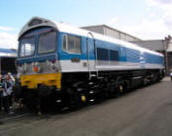 |
Class 59
A bit of an enigma, the Class 59 was a locomotive introduced solely
for Private Companies pre-privatisation. Foster Yeoman requested a
locomotive with 95%+ availability/reliability after class 56
locomotive availability fell at one point to 30%, which BR indeed
could not produce. Thus the company suggested they were allowed to
use private locomotives on BR lines, which was finally accepted.
Thus, they went to General Motors, who designed the 59 and was
introduced in 1986. Other companies later took some 59s on board,
including National Power. These were later used by EWS.
Foster Yeoman, EWS, National Power (?) |
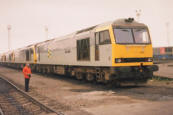 |
Class 60
A mainstay of the EWS fleet following privatisation, the 60s were
mainly used on Trainload Freight's operations before it. The 60 was
a direct response to the brilliant Class 59 and Brush came up with a
heavy freight locomotive still in use today. The 60 is used over the
new Class 66 on the heavier trains, it's higher horsepower and
tractive effort ratings meaning that it has less trouble hauling
steel, stone and heavy tanker trains. They were introduced in 1989.
Trainload Freight, EWS |
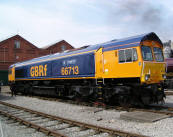 |
Class 66
A newer locomotive primarily used for heavy freight, the 66 is the
backbone of EWS freight services today. Upon privatisation in 1996,
a new locomotive was required and EWS returned to General Motors to
enquire. They delivered the Class 66 in 1998. The design has spread
right across Europe, known as Series 66. GBRf, Freightliner and DRS
also run Class 66 freight services.
EWS, Freightliner, DRS, GBRf |
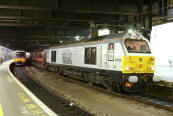 |
Class 67
Intended to be used on fast mail trains and to haul TPOs, the 67 is
a 125mph beast. With the loss of the mail contract by EWS in 2003,
the locomotive saw less and less use, as it's heavy axle-load barred
it from most lines. However, two are in use on the Royal Train and
one is painted in EWS Silver Executive livery. A return of` TPOs and
mail trains in 2005 saw limited use, but these are being superceded
by class 325 parcel EMUs.
EWS, EWS Executive, Royal Maroon |
Back to Top -
Back to Locomotives
|



















